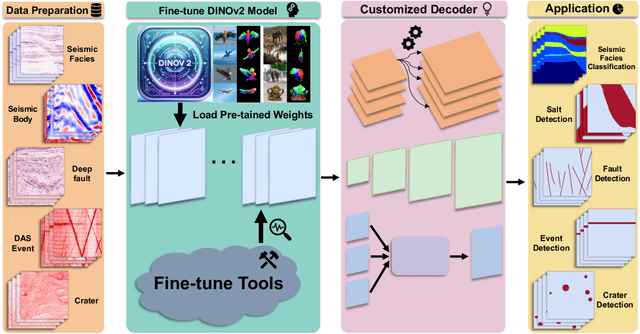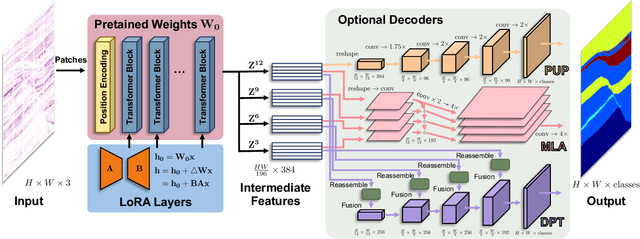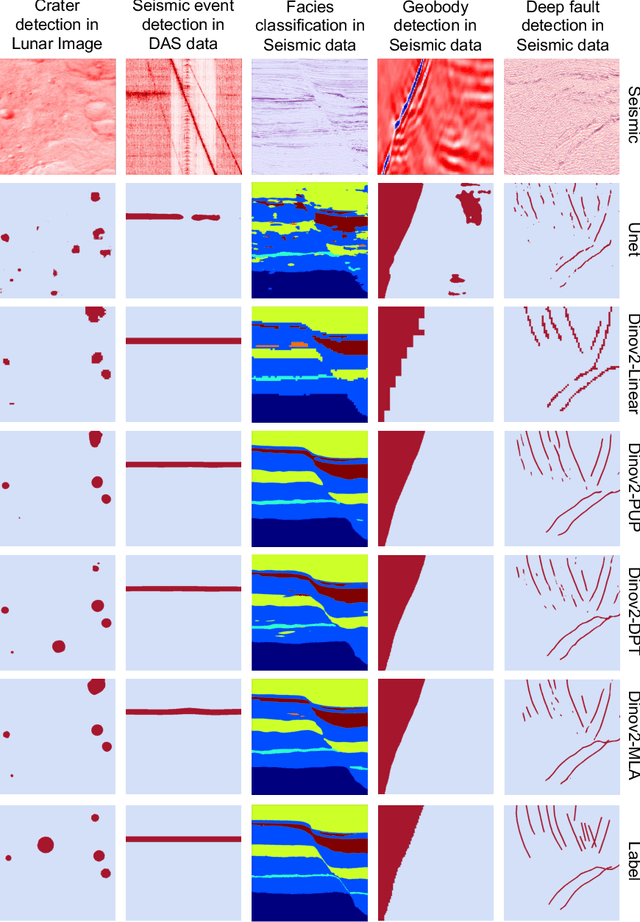Luming Liang
DistiLLM-2: A Contrastive Approach Boosts the Distillation of LLMs
Mar 10, 2025Abstract:Despite the success of distillation in large language models (LLMs), most prior work applies identical loss functions to both teacher- and student-generated data. These strategies overlook the synergy between loss formulations and data types, leading to a suboptimal performance boost in student models. To address this, we propose DistiLLM-2, a contrastive approach that simultaneously increases the likelihood of teacher responses and decreases that of student responses by harnessing this synergy. Our extensive experiments show that DistiLLM-2 not only builds high-performing student models across a wide range of tasks, including instruction-following and code generation, but also supports diverse applications, such as preference alignment and vision-language extensions. These findings highlight the potential of a contrastive approach to enhance the efficacy of LLM distillation by effectively aligning teacher and student models across varied data types.
Motion Graph Unleashed: A Novel Approach to Video Prediction
Oct 29, 2024Abstract:We introduce motion graph, a novel approach to the video prediction problem, which predicts future video frames from limited past data. The motion graph transforms patches of video frames into interconnected graph nodes, to comprehensively describe the spatial-temporal relationships among them. This representation overcomes the limitations of existing motion representations such as image differences, optical flow, and motion matrix that either fall short in capturing complex motion patterns or suffer from excessive memory consumption. We further present a video prediction pipeline empowered by motion graph, exhibiting substantial performance improvements and cost reductions. Experiments on various datasets, including UCF Sports, KITTI and Cityscapes, highlight the strong representative ability of motion graph. Especially on UCF Sports, our method matches and outperforms the SOTA methods with a significant reduction in model size by 78% and a substantial decrease in GPU memory utilization by 47%.
A foundation model enpowered by a multi-modal prompt engine for universal seismic geobody interpretation across surveys
Sep 08, 2024



Abstract:Seismic geobody interpretation is crucial for structural geology studies and various engineering applications. Existing deep learning methods show promise but lack support for multi-modal inputs and struggle to generalize to different geobody types or surveys. We introduce a promptable foundation model for interpreting any geobodies across seismic surveys. This model integrates a pre-trained vision foundation model (VFM) with a sophisticated multi-modal prompt engine. The VFM, pre-trained on massive natural images and fine-tuned on seismic data, provides robust feature extraction for cross-survey generalization. The prompt engine incorporates multi-modal prior information to iteratively refine geobody delineation. Extensive experiments demonstrate the model's superior accuracy, scalability from 2D to 3D, and generalizability to various geobody types, including those unseen during training. To our knowledge, this is the first highly scalable and versatile multi-modal foundation model capable of interpreting any geobodies across surveys while supporting real-time interactions. Our approach establishes a new paradigm for geoscientific data interpretation, with broad potential for transfer to other tasks.
Cross-Domain Foundation Model Adaptation: Pioneering Computer Vision Models for Geophysical Data Analysis
Aug 22, 2024



Abstract:We explore adapting foundation models (FMs) from the computer vision domain to geoscience. FMs, large neural networks trained on massive datasets, excel in diverse tasks with remarkable adaptability and generality. However, geoscience faces challenges like lacking curated training datasets and high computational costs for developing specialized FMs. This study considers adapting FMs from computer vision to geoscience, analyzing their scale, adaptability, and generality for geoscientific data analysis. We introduce a workflow that leverages existing computer vision FMs, fine-tuning them for geoscientific tasks, reducing development costs while enhancing accuracy. Through experiments, we demonstrate this workflow's effectiveness in broad applications to process and interpret geoscientific data of lunar images, seismic data, DAS arrays and so on. Our findings introduce advanced ML techniques to geoscience, proving the feasibility and advantages of cross-domain FMs adaptation, driving further advancements in geoscientific data analysis and offering valuable insights for FMs applications in other scientific domains.
FORA: Fast-Forward Caching in Diffusion Transformer Acceleration
Jul 01, 2024Abstract:Diffusion transformers (DiT) have become the de facto choice for generating high-quality images and videos, largely due to their scalability, which enables the construction of larger models for enhanced performance. However, the increased size of these models leads to higher inference costs, making them less attractive for real-time applications. We present Fast-FORward CAching (FORA), a simple yet effective approach designed to accelerate DiT by exploiting the repetitive nature of the diffusion process. FORA implements a caching mechanism that stores and reuses intermediate outputs from the attention and MLP layers across denoising steps, thereby reducing computational overhead. This approach does not require model retraining and seamlessly integrates with existing transformer-based diffusion models. Experiments show that FORA can speed up diffusion transformers several times over while only minimally affecting performance metrics such as the IS Score and FID. By enabling faster processing with minimal trade-offs in quality, FORA represents a significant advancement in deploying diffusion transformers for real-time applications. Code will be made publicly available at: https://github.com/prathebaselva/FORA.
AdaContour: Adaptive Contour Descriptor with Hierarchical Representation
Apr 12, 2024Abstract:Existing angle-based contour descriptors suffer from lossy representation for non-starconvex shapes. By and large, this is the result of the shape being registered with a single global inner center and a set of radii corresponding to a polar coordinate parameterization. In this paper, we propose AdaContour, an adaptive contour descriptor that uses multiple local representations to desirably characterize complex shapes. After hierarchically encoding object shapes in a training set and constructing a contour matrix of all subdivided regions, we compute a robust low-rank robust subspace and approximate each local contour by linearly combining the shared basis vectors to represent an object. Experiments show that AdaContour is able to represent shapes more accurately and robustly than other descriptors while retaining effectiveness. We validate AdaContour by integrating it into off-the-shelf detectors to enable instance segmentation which demonstrates faithful performance. The code is available at https://github.com/tding1/AdaContour.
S3Editor: A Sparse Semantic-Disentangled Self-Training Framework for Face Video Editing
Apr 11, 2024Abstract:Face attribute editing plays a pivotal role in various applications. However, existing methods encounter challenges in achieving high-quality results while preserving identity, editing faithfulness, and temporal consistency. These challenges are rooted in issues related to the training pipeline, including limited supervision, architecture design, and optimization strategy. In this work, we introduce S3Editor, a Sparse Semantic-disentangled Self-training framework for face video editing. S3Editor is a generic solution that comprehensively addresses these challenges with three key contributions. Firstly, S3Editor adopts a self-training paradigm to enhance the training process through semi-supervision. Secondly, we propose a semantic disentangled architecture with a dynamic routing mechanism that accommodates diverse editing requirements. Thirdly, we present a structured sparse optimization schema that identifies and deactivates malicious neurons to further disentangle impacts from untarget attributes. S3Editor is model-agnostic and compatible with various editing approaches. Our extensive qualitative and quantitative results affirm that our approach significantly enhances identity preservation, editing fidelity, as well as temporal consistency.
OTOv3: Automatic Architecture-Agnostic Neural Network Training and Compression from Structured Pruning to Erasing Operators
Dec 15, 2023Abstract:Compressing a predefined deep neural network (DNN) into a compact sub-network with competitive performance is crucial in the efficient machine learning realm. This topic spans various techniques, from structured pruning to neural architecture search, encompassing both pruning and erasing operators perspectives. Despite advancements, existing methods suffers from complex, multi-stage processes that demand substantial engineering and domain knowledge, limiting their broader applications. We introduce the third-generation Only-Train-Once (OTOv3), which first automatically trains and compresses a general DNN through pruning and erasing operations, creating a compact and competitive sub-network without the need of fine-tuning. OTOv3 simplifies and automates the training and compression process, minimizes the engineering efforts required from users. It offers key technological advancements: (i) automatic search space construction for general DNNs based on dependency graph analysis; (ii) Dual Half-Space Projected Gradient (DHSPG) and its enhanced version with hierarchical search (H2SPG) to reliably solve (hierarchical) structured sparsity problems and ensure sub-network validity; and (iii) automated sub-network construction using solutions from DHSPG/H2SPG and dependency graphs. Our empirical results demonstrate the efficacy of OTOv3 across various benchmarks in structured pruning and neural architecture search. OTOv3 produces sub-networks that match or exceed the state-of-the-arts. The source code will be available at https://github.com/tianyic/only_train_once.
The Efficiency Spectrum of Large Language Models: An Algorithmic Survey
Dec 01, 2023Abstract:The rapid growth of Large Language Models (LLMs) has been a driving force in transforming various domains, reshaping the artificial general intelligence landscape. However, the increasing computational and memory demands of these models present substantial challenges, hindering both academic research and practical applications. To address these issues, a wide array of methods, including both algorithmic and hardware solutions, have been developed to enhance the efficiency of LLMs. This survey delivers a comprehensive review of algorithmic advancements aimed at improving LLM efficiency. Unlike other surveys that typically focus on specific areas such as training or model compression, this paper examines the multi-faceted dimensions of efficiency essential for the end-to-end algorithmic development of LLMs. Specifically, it covers various topics related to efficiency, including scaling laws, data utilization, architectural innovations, training and tuning strategies, and inference techniques. This paper aims to serve as a valuable resource for researchers and practitioners, laying the groundwork for future innovations in this critical research area. Our repository of relevant references is maintained at url{https://github.com/tding1/Efficient-LLM-Survey}.
DREAM: Diffusion Rectification and Estimation-Adaptive Models
Nov 30, 2023Abstract:We present DREAM, a novel training framework representing Diffusion Rectification and Estimation-Adaptive Models, requiring minimal code changes (just three lines) yet significantly enhancing the alignment of training with sampling in diffusion models. DREAM features two components: diffusion rectification, which adjusts training to reflect the sampling process, and estimation adaptation, which balances perception against distortion. When applied to image super-resolution (SR), DREAM adeptly navigates the tradeoff between minimizing distortion and preserving high image quality. Experiments demonstrate DREAM's superiority over standard diffusion-based SR methods, showing a $2$ to $3\times $ faster training convergence and a $10$ to $20\times$ reduction in necessary sampling steps to achieve comparable or superior results. We hope DREAM will inspire a rethinking of diffusion model training paradigms.
 Add to Chrome
Add to Chrome Add to Firefox
Add to Firefox Add to Edge
Add to Edge